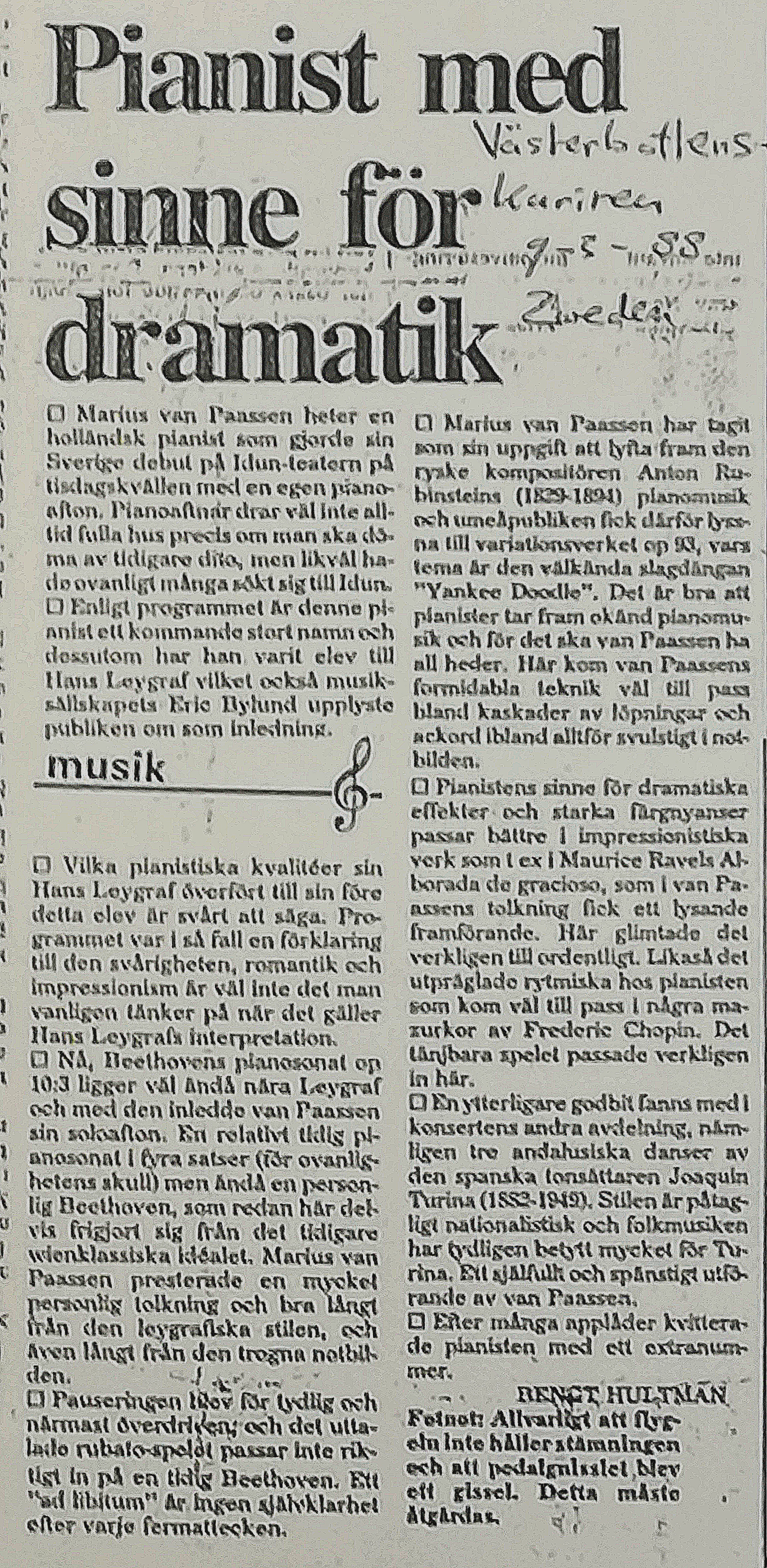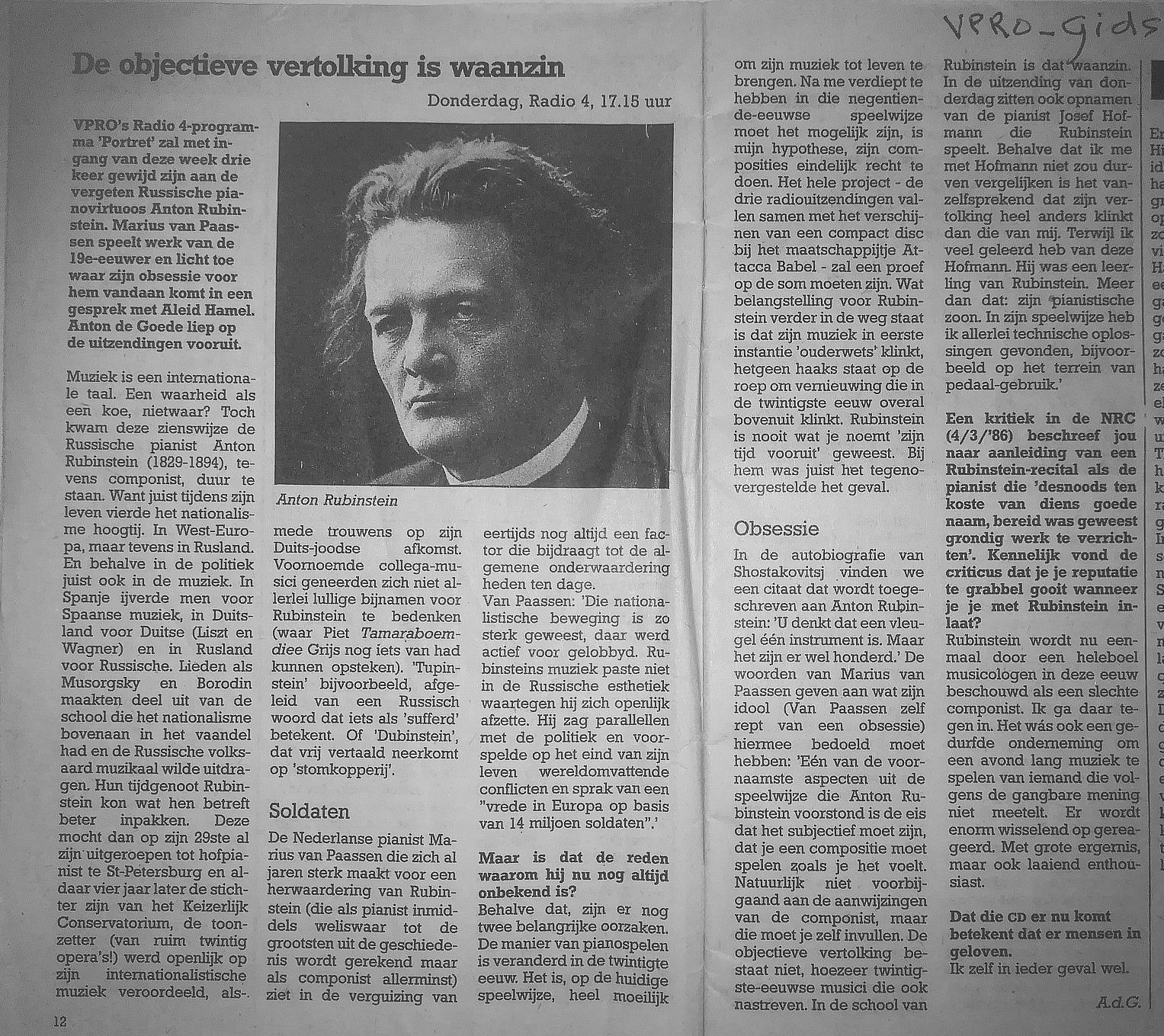



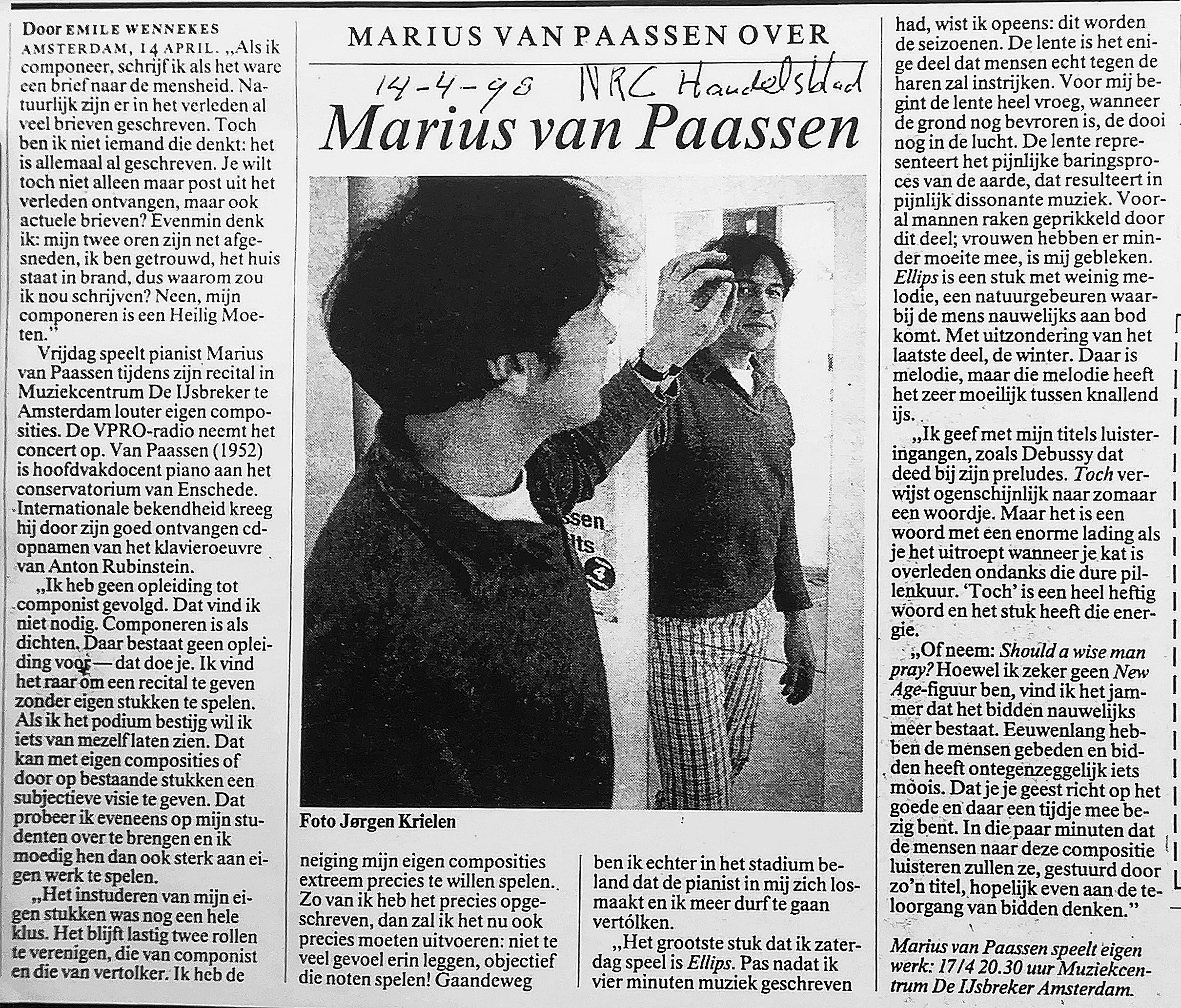
|
Vrij Nederland 8 maart 2014 Herinnert u zich de ophef nog toen popmuzikant Beck zijn nieuwe album Song Reader presenteerde als een stapeltje bladmuziek? Wie wilde weten hoe zijn nieuwe liedjes klonken, moest ze zelf spelen. Klassieke muzikanten verbaasden zich over de ophef, want noten lezen vinden zij heel gewoon. Bij hen is het weer bijzonder om eigen composities te spelen, zoals de pianist Marius van Paassen doet op een dubbel-cd. Als bonus levert hij er een cd-rom bij met de bladmuziek. Bij ons weten een geheel nieuw concept. Laat de ophef beginnen. 'Marius van Paassen plays Marius van Paassen', Attacca 133/134/135 www.opusklassiek.nl © Siebe Riedstra, juni 2014 Marius van Paassen WONDER |
|
Marius van Paassen (1952) heeft in de eerste plaats een reputatie als pianist. Een aardige bijkomstigheid is dat zo'n dertig geleden een alleraardigste elpee uitkwam op hetzelfde label, toen nog Attacca Babel geheten. De titel: ‘The animal in the 20th century piano music'. Met nu eens niet het Carnaval der dieren, maar volwassen stukken als Oiseaux tristes, Poissons d'or, en de Circus elephant. Ze is heruitgegeven op cd, en wat er zo bijzonder aan is zijn ‘Les éléphants' van Alexander Voormolen en de Preludes opus 17 van Bernard van den Sigtenhorst Meyer, acht miniatuurtjes met titels als Kat, Kameel en Marabou. Voormolen laat met zijn olifanten horen dat hij een van de weinige Nederlanders is die op internationaal niveau virtuoze pianomuziek weet te schrijven. Repertoire dat u nergens anders zult tegenkomen, en wonder boven wonder nog steeds verkrijgbaar (Attacca 1989.50). Na een bloeiende loopbaan op het podium met muziek van anderen begon van Paassen er steeds meer zin in te krijgen om zijn eigen muziek te maken. Hier presenteert hij zelf het resultaat van een kwart eeuw componeren onder de titel WONDER. Die paraplu is ingegeven door de titel van enkele preludes uit de bundel ‘I wonder', die je hier moet vertalen met ‘ik vraag me af': wat gebeurt er als ik aan de piano ga zitten en mijn fantasie de vrije loop laat? Het oudste stuk op deze uitgave is ‘Laurel and Hardy in Chernobyl' (1988), het jongste ‘Houellebecq reading Lovecraft' (2011). Dat dit juist twee anecdotische titels zijn is overigens niet kenmerkend voor de inhoud van de beide cd's. De hoofdmoot bestaat in de eerste plaats uit abstractere vormen: Preludes, Dansen en een Sonate. Beluistering leert dat van Paassen zich in het hedendaagse ‘postmodernisme' als een vis in het water voelt. Hij combineert zijn rijke pianistische ervaring met de oogst van het minimalisme en de wereld van de jazz. De virtuose pianoklanken zoals die in het Parijs van de jaren twintig geklonken hebben worden moeiteloos gecombineerd met de verworvenheden van minimalisten als John Adams en Simeon ten Holt. Daarbij moet direct opgemerkt worden dat er van epigonisme geen sprake is, en dat komt simpelweg door de improvisatorische ‘stream of consciousness' die aan deze stukken ten grondslag ligt, en het voor de luisteraar makkelijk maakt om de ideeënstroom te volgen, ook als het idioom de dissonant niet schuwt. Een en ander wordt gepresenteerd in een prachtig ontworpen digipack, maar ik geef u wel de raad om het losse boekje met een elastiekje aan de verpakking vast te maken, anders raak je dat gegarandeerd binnen de kortste keren kwijt. Als extra biedt deze uitgave de bladmuziek van de gespeelde werken op een derde schijf, waar alles in pdf formaat meegelezen, of beter nog, gespeeld kan worden. Overigens moet je dan van goeden huize komen, makkelijk zijn deze noten allerminst. Opvallend is het gedetailleerde gebruik van het middelste pedaal, door Victor Borge ooit gekarakteriseerd als ‘the pedal in the middle is there to keep the other two apart'. Heel kort door de bocht dient het ervoor om bepaalde lage snaren mee te kunnen laten resoneren zonder ze aan te slaan. Uiteraard heeft van Paassen er zelf niet de minste moeite mee, en hij heeft bovendien een schitterende Fazioli vleugel tot zijn beschikking, die tijdens de opnamesessies keurig werd bijgehouden door pianotechnicus Evert Snel. Jochem Geene zorgde voor een natuurlijke opname die precies bij deze muziek past: het is alsof Marius van Paassen met zijn Fazioli in uw huiskamer is neergestreken om u te onderhouden met zijn klankvondsten en zijn virtuositeit. Tot slot een verzoeknummer: de ‘Tableaux des Pays-Bas' van Alexander Voormolen in een uitvoering door Marius van Paassen. Voordat het te laat is.
|





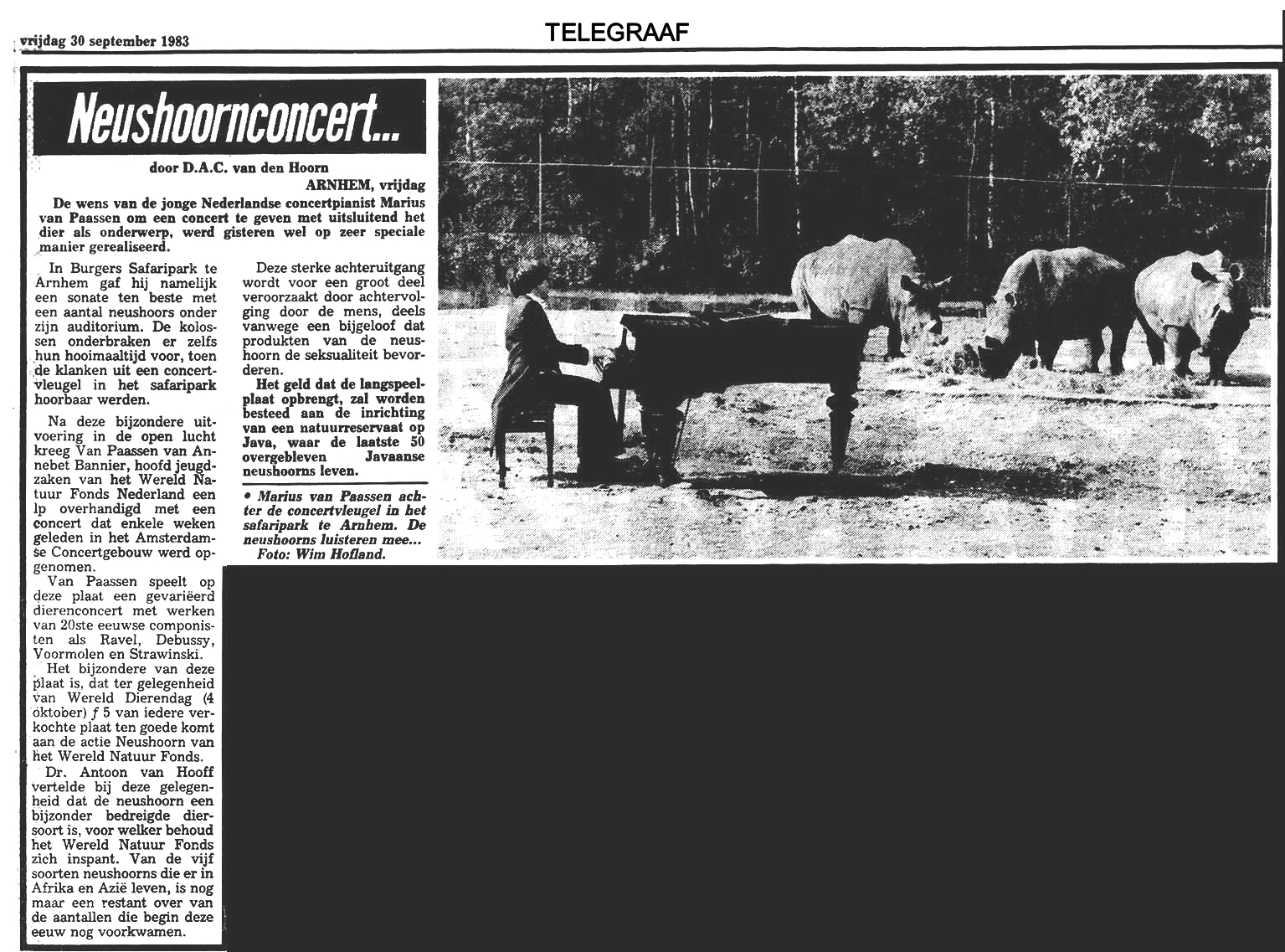


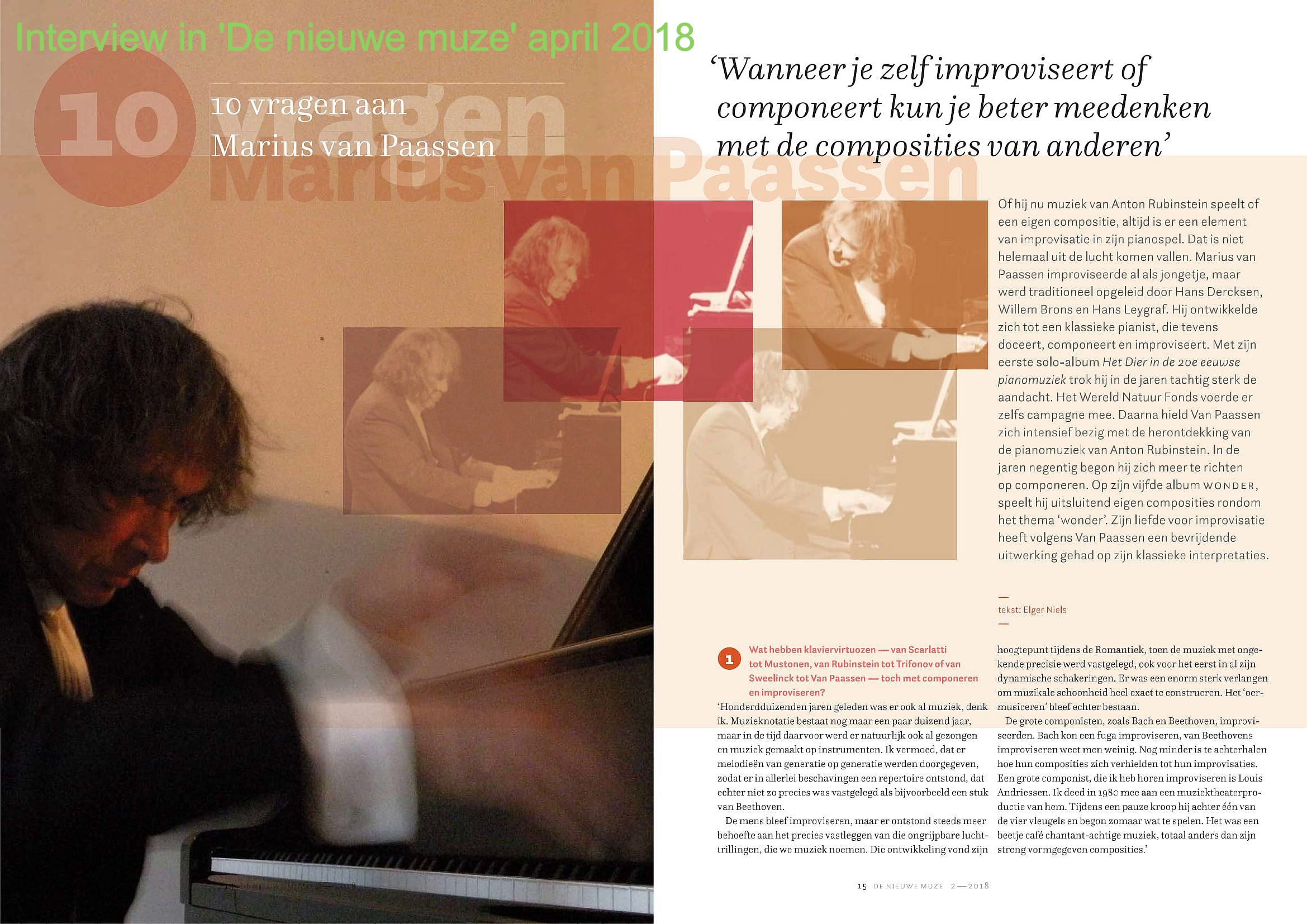
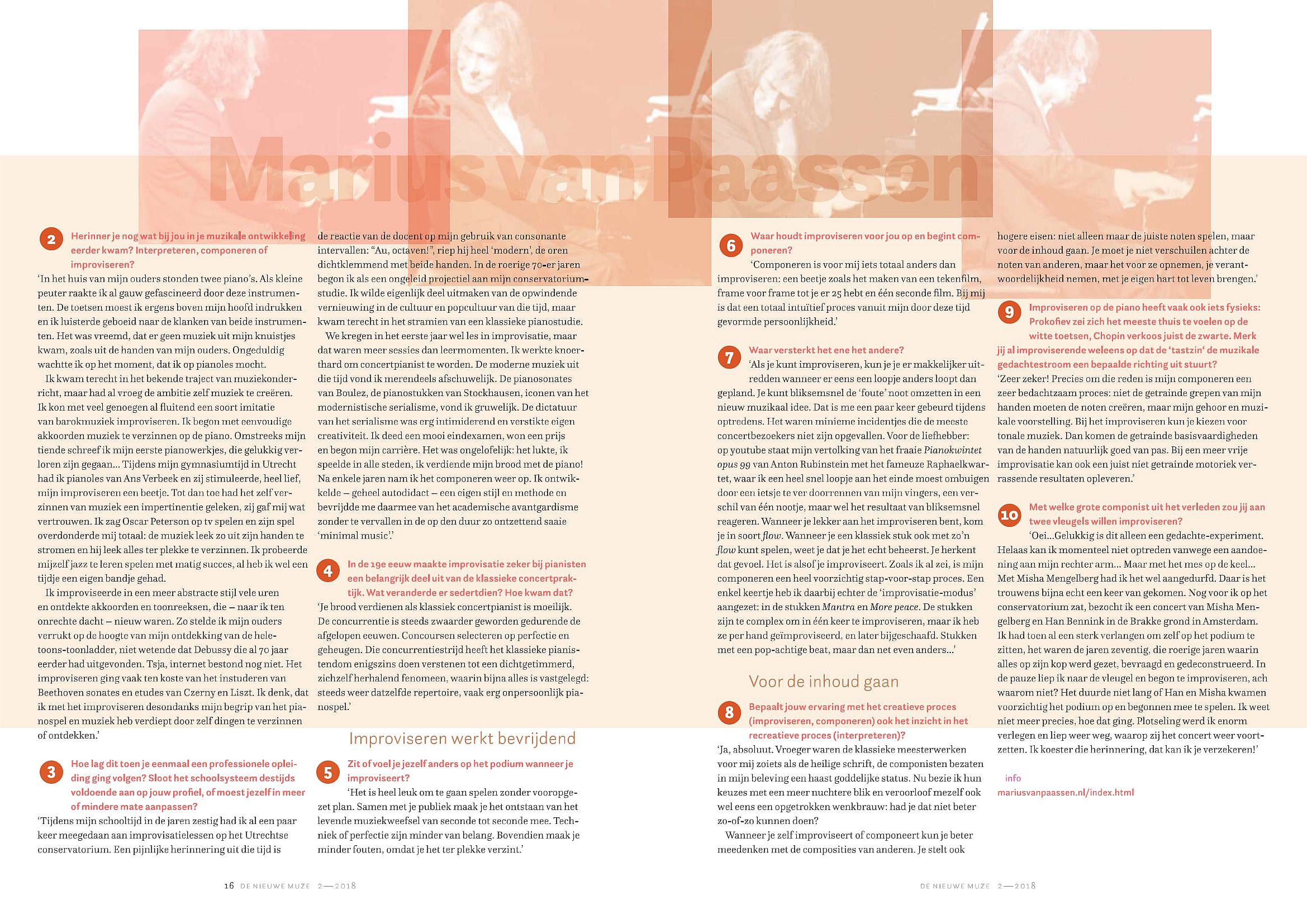
SOME PRESS QUOTATIONS
ITALY
Eco di Bergamo
acrobata eccezionale delta tastiera .... a love for Anton Rubinstein that was deepened by our young Dutchman with a spirited enthusiasm playing the piano with the incomparable virtuosity of the great concerto player.The attentive audience was numerous and enthusiastic.
SWEDEN
Vasterbutens kuriren
PIANIST WITH SENSE FOR DRAMA
His sense for drama and strong colour nuance suits well impressionistic works like for instance Alborada del gracioso of Maurice Ravel, wich got a superb interpretation by Van Paassen. Sparkling.
USA
Fanfare magazine
His playing is very much in the grand rornantic tradition. The results are DAZZLING. Anyone with a whit of interest in Anton Rubinstein's work or the Romantie Revival in general cannot afford to overlook this issue. Anton Rubinsteins pianoworks Attacca Babel 8741-4
The Classical Music Guide Forums 2006
Now, here is
an interesting group of ten piano solo pieces by pianist/composer
Anton Rubinstein collectively entitled Le Bal, Op. 14: Fantaisie for
Piano on Ten Numbers for Altesse Madame, Princess Sophie de Nassau
(1824-1897), the daughter of Holland's King Wilhelm II and his
Russian-born wife, Queen Anna Pavlovna. It appears on the Attaca
label [9268, DDD, 61:39].
His music fared well on the programs of
performers such as Liszt, Saint-Saëns, Brahms, von Bülow,
Josef Hofmann, and others of their ilk. The great singer, bass Feodor
Chaliapin also included many of Rubinstein's songs in his recitals.
Le Bal is essentially dance music and each piece tells a
story. For example, the first piece, "Impatience," displays
the excitement before the start of the party. The other sections are
marked Polonaise, Contredance, Waltz, Intermezzo, Polka,
Polka-Mazurka, Mazurka, Galop and Le Rêve. These are some of
the most charming piano solos I have found written by Rubinstein,
colourfull, full of life, and most virtuosic for the piano, who
almost makes his sound into a full orchestra.
The pianist,
Marius van Paassen was first known to me on another Attaca CD
recording [8741], which contained a phenomenal version of Anton
Rubinstein's Yankee Doodle Variations, the Piano Sonata, Op. 100, and
a Prelude. The Yankee Doddle Variations was programed once on a July
4th radio tribute I presented, which brought forth many calls and
letters, indicating people do recognize something different (and
good) when they hear it. Marius Van Paassen studied at the Sweelinck
Conservatory in Amsterdam and in Hannover, taking a number of
national prizes. He is the one pianist who has performed the solo
music of Anton Rubinstein in recital more than any other pianist. Van
Paassen debuted with the Concergebouw in 1982 when he performed
Tchaikovsky's First Piano Concerto. One recording he made, entitled
"The Animal in Twentieth Century Piano Music" was a
sell-out when it was first issued (wish I had it!). He also won a
national prize for his performance of Beethoven's Piano Sonata No.
32, Op. 111. Van Paassen possesses a huge sound, articulates the
piano keys with great expertise and enthusiasm…
Lance G. Hill

THE NETHERLANDS
NRC Handelsblad
Marius van Paassen convincingly paved the way for Rubinstein with brilliant interpretations of his pianosonate opus 100 and variations on YANKEE DOODLE.(Leo Samama) ATTACCA BABEL 87414
VOLKSKRANT
Tijd onbarmhartig voor componist Rubinstein.
Marius van Paassen beschikt over een goede techniek en weet de notenvloed een duidelijk reliëf mee te geven. Vooral de zuiver pianistische overmoed van 'Le bal', opus 14 gaat hem goed af.
LUISTER
Deze muziek moet eerst bezield worden voor ze tot leven komt. De grandeur die het op deze CD krijgt, komt uit het spel van Marius van Paassen die als de reïncarnatie van een negentiende- eeuwse pianoleeuw de frases kneedt en zeggingskracht geeft.
Pianowerken Anton Rubinstein, ATTACCA BABEL 8741-4
NRC HANDELSBLAD
Marius van Paassen is uitzonderlijk getalenteerd, waarbij de intensiteit van zijn vertolkingen heel erg de aandacht trekt. Met name zijn spel in Debussy, Ravel en Messiaen maakte diepe indruk.
TROUW
De langdurige staande ovatie mag zeker als bewijs gelden, dat de Rotterdamse muziekliefhebbers Marius van Paassen graag weer willen horen.
PAROOL
Ouderwets overrompelende bravoure. De vele flitsende wisselingen in de uitdrukking kwamen in miraculeuze overeenstemming tussen orkest en vleugel tot hun recht.
TROUW
Zulk contrastrijk spel kon de sonate opus 31 no. 3 van Ludwig van Beethoven ook heel goed hebben. De vertolking van deze sonate zonder langzaam deel straalde vreugde aan het musiceren uit. waar dit werk in hoge mate om vraagt en zo werd het een groot genot te luisteren naar de zingende hoekdelen van het menuet en naar de sprankelingen en flonkeringen in de drie andere delen.
Leidsch dagblad
Ronduit verassend was de première van een drietal composities van Marius van Paassen zelf. Met name 'Laurel en Hardy in Tsjernobil' maakte een verpletterende indruk. Vrolijke syncopische deuntjes geplaatst tegen de beangstigende achtergrond van kerncentrales en de onvermijdelijke atoomramp.
NRC Handelsblad
This very French-coloured piano playing- on this CD named: The Amsterdam recital- is absolutely not aggressive. (Ernst Vermeulen)

Eindhovens dagblad
Voor veel luisteraars zal de sonate van Grieg een openbaring hebben betekend: het is merkwaardig dat dit sprankelende stuk niet zo dikwijls te beluisteren valt. Van Paassen hield een goed pleidooi voor deze compositie, met name in het tweede deel, Andante molto
Pianowereld
Eindelijk is hier weer eens een componist die pianistiek heel goed schrijft en duidelijk bij de traditie durft aan te knopen.
Amersfoortse courant
Zijn Mendelsohn klonk wisselend genuanceerd, krachtig en briljant, terwijl hij in de sonate opus 31 nr 3 van Beethoven een intelligente betoogtrant ontwikkelde. Rijk aan stemmingen en op momenten met een diepgang die opmerkelijk mocht heten.
Eindhovens dagblad
De structuur van de Images wordt veelal bepaald door elementen als dynamiek en klankleur, hetgeen in het spel van marius van Paassen zo subliem tot zijn recht komt.
Gooi en Eemlander
De pianist Marius van Paassen weet hoe de betrokken componist dient te worden benaderd, zulks gezien de aan de dag gelegde allure en het feit, dat hij elke toon weet te laten zingen.
De Tijd
Negentiende-eeuwse virtuositeit in optima forma, de pianomuziek van anton rubinstein, maar dankzij Van Paassens inbreng veel meer dan rariteit; al krijgt het sentiment het volle pond, zijn glasheldere spel beneemt toch nergens het zicht op de architectuur.
USA
Le Bal Anton Rubinstein Marius van Paassen piano****
An Apotheosis of dance as much as an Apotheosis of pianistic virtuosity
By Discophage Top 500 reviewer
April 7, 2015
A nice and entertaining cycle, and a fine
discovery by Dutch pianist Marius Van Paassen. The music is
superficial and flashy, very end-of-century salon virtuoso, but it is
evocative, fun, and even impressive. It's a collection of dances as
they might have been played at the Czar's court, where Rubinstein was
the official pianist when he composed his cycle in 1854, with a
Polonaise (track 2), a series of Contredanses (3), a Walz (4), a
Polka, Polka-Mazurka and Mazurka (6 - 8) and a final Galop (9), but
it's more than that. As the liner notes aptly put it, "Le Bal
(1854) contains dance music, but the work is also an expression of
the feelings induced by a 19th century danceparty. The first piece -
Impatience - splendidly portraits the excitement before the start of
the party. One already hears fragments of the dances that will be
played later". The cycle ends with "Le Rêve" -
the dream, but a dream interrupted by nightmarish memories of the
evening's frienzied danses.
As flashy and superficial and at
times rompingly loud (end of the Contradanses, Galop) as the cycle
may be, one cannot fail to be impressed by the way, in the Polonaise
for instance, Rubinstein develops and varies a relatively thin
material - and the virtuosity IS immense, making the score, at times
(anonymous gratitude to whoever uploaded it on the International
Music Scores Library Project), almost a work of visual art as some
contemporary scores (the wedge-shape of both hands in the final
measures looks like the opened jaws of some strange cartoon dog
spitting out fumes from its nostrils). On the surface, the long Waltz
may start like Chopin's most superficial and Bellinian in the genre,
but the piano writing goes way further than Chopin in its elaboration
and rhythmic ambiguity, and Rubinstein develops the Walz, in the
course of its 7:37 minutes, way beyond its beginning point, in an
almost frenzied way, as if he were trying to contain in a single
piece all the past AND future of that dance-form. The same is true
with the Polka - truly, the most superficial and hollow musical form,
with its echoes of Offenbach, but that Rubinstein transforms into a
pianistic tour-de-force - and the Polka-Mazurka, to which he brings
genuine drama.
And, following from the score, awed by the
pianistic complexity and virtuosity that Rubinstein brings to these
often simplistic dance-forms, one understands that the composer is
celebrating simultaneously an Apotheosis of the Dance and an
Apotheosis of the piano and pianistic virtuosity. In that context,
the last piece, The Dream, is opened to interpretation: the "sweet
slumber" after the exhaustion of the evening, as the
(uncredited, but presumably by the pianist himself) liner notes
suggest, or is Rubinstein expressing that all this was only his dream
of the dance?
Always hard to judge an interpretation on its
own, in the absence of comparisons, but following with the score, Van
Paassen seems to play with total accuracy, no shortage of velocity
(his no-holds-barred, frienzied take on the final Galop, track 9, is
pretty hair-raising), and great poetic imagination, capturing well,
for instance, the agitated impatience of the opening piece. He's also
very imaginative in the way he varies his touch in the repeats of
some sections of the Waltz (2:58 and 3:12), and I appreciate that he
doesn't milk the ritards in the Mazurka and keeps his tempo always
flowing (track 8).
Afbeelding
1: Foto Ben Krimp
